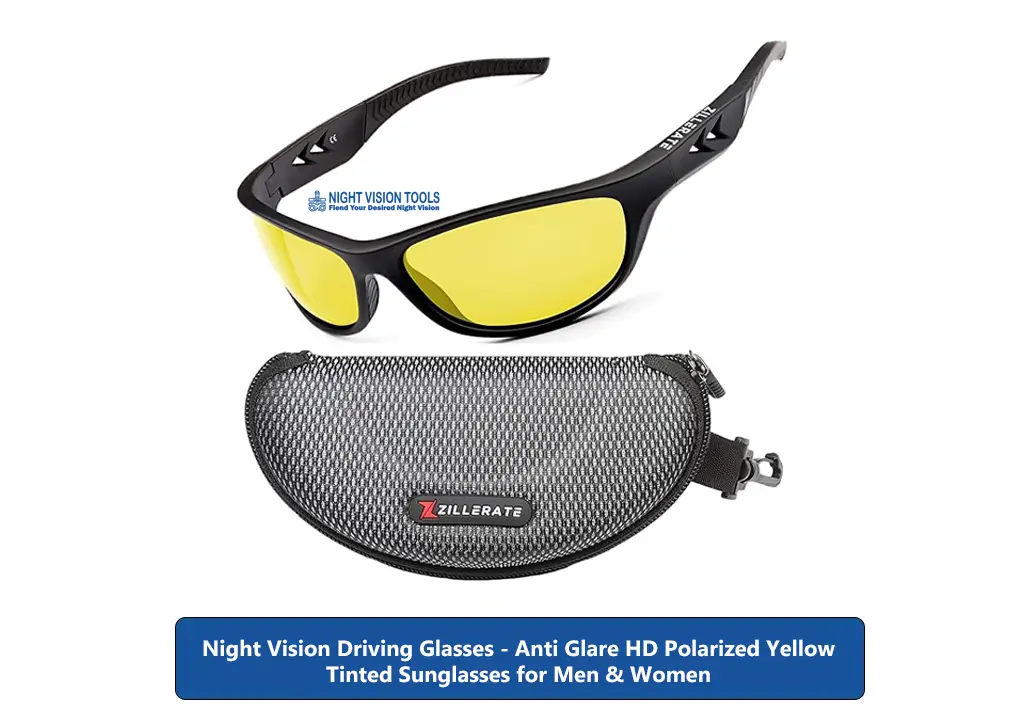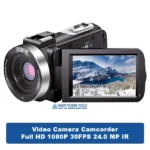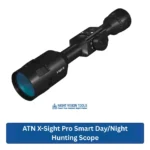Night Vision Driving Glasses at night is inherently more dangerous than daytime driving. Reduced visibility, oncoming headlight glare, and the dim lighting of rural or suburban roads contribute to increased stress, slower reaction times, and a higher risk of accidents. Night vision driving glasses are specifically engineered to address these issues. These glasses typically feature yellow-tinted lenses, anti-glare coatings, and polarized filters to enhance clarity, contrast, and visual comfort after sundown. In this comprehensive guide, we will explore every facet of night vision driving glasses—from how they work to what features you should prioritize—ensuring that your next drive at night is safer, clearer, and less stressful.
Understanding the Need for Night Vision Driving Glasses
Night driving accounts for a disproportionate number of traffic fatalities. Despite making up only 25% of total driving time, nighttime driving is responsible for over 50% of car crashes. This is due to several factors: reduced light, pupil dilation which decreases depth perception and peripheral vision, and high contrast between headlights and dark surroundings. Additionally, older adults often suffer from age-related vision declines, such as cataracts and reduced night vision acuity, further increasing the need for visual enhancement. Night Vision Driving Glasses offer a non-invasive, cost-effective way to combat these issues, helping drivers see more clearly and respond more confidently behind the wheel.
The Science Behind Anti-Glare Technology
Glare occurs when an intense light source, such as headlights or streetlights, scatters in the eye, reducing visibility and increasing discomfort. Anti-glare technology in night driving glasses is designed to reduce this scattered light. The anti-reflective coating on the lens minimizes internal and external reflections, allowing lighter to pass through the lens cleanly. Furthermore, polarized lenses block horizontal light waves—common in reflections from wet pavement or glass—enhancing clarity and reducing eye fatigue. Yellow-tinted lenses, which filter blue light, are especially beneficial in low-light conditions as they heighten contrast and improve depth perception, helping you see better at night or in foggy weather.
Benefits of HD Polarized Yellow Tinted Lenses
High definition (HD) polarized lenses provide exceptional optical clarity. The yellow tint increases contrast by reducing blue light, which is more scattered and contributes to haze. This results in sharper vision with less glare, particularly beneficial when driving at night or during dusk and dawn. Polarization further enhances this benefit by filtering out blinding glare from oncoming headlights or reflective surfaces. Other advantages include reduced eye fatigue during long drives, improved reaction time due to clearer vision, and an overall more comfortable visual experience. Combined, HD polarization and yellow tinting make a powerful tool for safe nighttime navigation.
How Night Driving Glasses Improve Safety
Night Vision Driving Glasses don’t just improve comfort—they directly impact safety. By enhancing visibility and reducing glare, drivers can identify road signs, obstacles, pedestrians, and other vehicles more easily. The reduction of visual distractions helps maintain focus, which is crucial when road conditions are poor, or visibility is limited. Studies suggest that wearing anti-glare eyewear can significantly improve braking reaction times and lane control. For older drivers or individuals with light sensitivity, these Night Vision Driving Glasses may prevent dangerous overreactions to sudden flashes of light, ensuring a more controlled and confident driving experience.

Who Should Use Night Vision Driving Glasses?
These glasses are ideal for a wide demographic. Older adults, who experience age-related decline in night vision, benefit immensely from the contrast-enhancing effects. Professional drivers, such as truckers or delivery personnel, often spend extended hours driving at night and require reduced eye strain. People with light-sensitive eyes or mild visual impairments can also find relief using these glasses. Even casual drivers who feel uncomfortable during nighttime trips can improve their confidence and safety. While not a replacement for prescription lenses or eye health treatment, night vision driving glasses serve as an excellent supplemental tool for better visibility and peace of mind.
Features to Look for in Night Vision Driving Glasses
Not all-night driving glasses are created equal. When shopping for a pair, consider the following key features:
- Polarized Lenses: Essential for reducing horizontal glare from road surfaces and headlights.
- Yellow or Amber Tint: Improves contrast and filters blue light, enhancing clarity in low-light conditions.
- Anti-Reflective Coating: Helps prevent internal reflections within the lens.
- UV Protection: Ensures eye safety during both night and day.
- Durable Frame Material: Lightweight, comfortable, and built to last.
- Scratch-Resistant Coating: For long-term clarity and usability.
- Prescription Compatibility: For users who require corrective lenses.
Make sure to evaluate these features based on your specific needs and driving environment.
Comparing Yellow Tinted Glasses vs. Clear or Other Tints
Yellow lenses offer distinct advantages in low-light settings by increasing contrast and reducing blue light interference. Clear lenses, on the other hand, provide no contrast enhancement but may still reduce glare if coated with anti-reflective material. Amber tints, slightly darker than yellow, are better suited for daytime driving in fog or overcast conditions but may be too dark for nighttime use. Blue or mirrored lenses are typically reserved for bright sunlight and are not recommended for night driving. When compared across the board, yellow-tinted polarized glasses remain the most effective for nighttime or dusk/dawn visibility enhancement.
Real-World Testimonials and Customer Experiences
Drivers from all walks of life have shared overwhelmingly positive feedback about Night Vision Driving Glasses. Commonly cited benefits include improved clarity, less squinting, reduced eye fatigue, and greater confidence during nighttime travel. Many reviewers highlight the dramatic difference these glasses made in navigating winding rural roads or dealing with high-beam headlights. Some even report enhanced visual acuity during fog or rain. These real-world testimonials underline the practical value of the technology and affirm its role as an essential driving accessory, especially for those who frequently drive after sunset.
How to Choose the Right Frame Style for Comfort and Fit
Comfort is crucial, especially during long night drives. Frame styles vary from wraparound designs that block peripheral light to lightweight minimalist options ideal for eyeglass wearers. Choosing the right frame involves considering materials like TR90 (flexible, durable), metal (sturdy, professional look), or plastic (budget-friendly and lightweight). Adjustable nose pads and temple tips can prevent pressure points. Additionally, frames should offer a snug fit without slipping, particularly when worn for extended periods. Some models are designed to be worn over prescription glasses (OTG), which is ideal for drivers with vision correction needs.

Prescription vs. Non-Prescription Night Vision Driving Glasses
While most Night Vision Driving Glasses are non-prescription, many users require visual correction. Prescription-compatible options are either clip-ons, OTG frames, or custom-made lenses that integrate both corrective power and glare-reducing features. If you wear glasses daily, choosing a pair that accommodates your prescription or fits seamlessly over your glasses ensures better results. Investing in a prescription night vision pair, although more expensive, enhances clarity and reduces distortion—making your night drives much safer.
Night Vision Glasses for Motorcyclists and Cyclists
Two-wheel commuters are especially vulnerable to night-driving hazards. Reduced visibility and headlight glare can impair reaction time and increase accident risk. For motorcyclists and cyclists, Night Vision Driving Glasses offer enhanced visibility and contrast on the road. Look for wraparound, impact-resistant designs with anti-fog coatings. UV protection is also a must, especially for early morning or late evening rides. Lightweight and shatterproof frames ensure both safety and comfort in various environments.
Anti-Fog and Weatherproof Coatings for All Conditions
Fogging can be a major nuisance, particularly when transitioning between warm and cold environments. Premium Night Vision Driving Glasses come with anti-fog coatings that keep lenses clear in humid or cold conditions. Some even offer hydrophobic coatings that repel rain and snow, ensuring your vision remains unobstructed. For drivers in regions with variable weather—like heavy rain, snow, or high humidity—these features are critical in maintaining optimal clarity and safety on the road.
Debunking Common Myths About Night Vision Driving Glasses
There are several misconceptions about Night Vision Driving Glasses. Some believe all yellow lenses improve night vision—while many do, poor-quality ones may darken your vision further. Others think these glasses are only for older drivers, but they benefit all ages. Another myth is that polarized lenses reduce visibility at night; in truth, quality polarization filters harsh glare while maintaining clarity. Separating fact from fiction ensures you make an informed purchase and use the glasses correctly.
How Night Driving Glasses Compare to Anti-Glare Windshields
Some vehicles offer built-in anti-glare windshields or rearview mirrors. While helpful, they don’t filter all types of glares or improve contrast like Night Vision Driving Glasses do. Night driving glasses work directly with your eyes, reducing reflections from multiple angles and enhancing the overall field of vision. Used together, glasses and built-in vehicle technologies create a powerful combination for maximum visibility and eye protection.
Night Driving Glasses for Urban vs. Rural Driving
Urban areas often have ample street lighting but also suffer from light pollution and reflections. Rural roads, on the other hand, are poorly lit and rely heavily on high-beam headlights. In urban settings, night glasses help cut excessive glare, while in rural zones, they enhance visibility and contrast. Selecting a lens with the right level of tint and polarization is important depending on where you drive most frequently.

Enhancing Your Driving Performance with Better Vision
Good vision directly impacts your reaction time, lane accuracy, and overall awareness. Night Vision Driving Glasses enhance performance by reducing distractions and helping your eyes adapt to darkness more efficiently. You’ll notice clearer road markings, sharper outlines of objects and vehicles, and better depth perception—all contributing to safer and more confident driving. In situations where seconds matter, enhanced vision can be life-saving.
The Cost-Effectiveness of Night Driving Glasses
Compared to the price of vehicle modifications or frequent eye doctor visits, Night Vision Driving Glasses are highly affordable. Many effective models cost under $50 and provide years of use. Their durability, combined with the safety benefits they offer, makes them a cost-efficient investment. Some high-end models may come with replaceable lenses or lifetime warranties, further increasing their value.
Night Vision Driving Glasses for Elderly Drivers
Age-related eye changes such as cataracts, macular degeneration, and reduced contrast sensitivity can make night driving particularly dangerous for seniors. Night Vision Driving Glasses offer a practical aid for elderly drivers by enhancing contrast and reducing discomfort from headlights. Lightweight frames, prescription options, and UV protection are key features for this demographic. Encouraging the use of such glasses can empower older adults to retain their independence while staying safe.
Importance of Blue Light Blocking for Night Driving
Blue light from LED headlights, dashboard screens, and oncoming traffic can cause visual fatigue and disrupt your sleep cycle. Night Vision Driving Glasses with blue light-blocking filters reduce this strain, helping your eyes stay relaxed during long nighttime trips. This feature also benefits professional drivers and commuters who experience frequent screen use before or after driving.
Night Vision Glasses for Truck Drivers and Commercial Operators
Long-haul truckers and commercial vehicle operators spend extended hours on the road, often at night. Eye strain and glare can affect judgment and lead to fatigue. Night Vision Driving Glasses tailored for commercial use are usually more robust, have broader lens coverage, and come with enhanced anti-glare technology. These tools become essential safety gear in the professional driving world.

Comparing Yellow-Tinted vs. Clear Lenses for Night Use
While yellow-tinted lenses are the most popular for night driving, some drivers prefer clear lenses with anti-reflective coatings. Yellow lenses improve contrast and depth perception in low light, whereas clear lenses offer better natural vision with less color distortion. The choice depends on individual eye sensitivity and the driving environment, but both options enhance safety.
The Role of Lens Curvature in Optical Clarity
Curved lenses provide a wide, unobstructed view, especially useful for drivers who must scan roads. A wraparound design ensures minimal distortion at the edges and better peripheral vision. Modern manufacturing techniques reduce optical aberrations in curved lenses, giving drivers an advantage in spotting potential hazards earlier and more clearly.
How to Maintain and Clean Your Night Driving Glasses
Keeping lenses clean ensures maximum visibility and performance. Always use a microfiber cloth and lens-safe cleaner. Avoid abrasive wipes or paper towels, which can scratch anti-glare coatings. Store glasses in a hard case to prevent damage. Regular cleaning extends their lifespan and preserves the effectiveness of polarization and anti-reflective layers.
Night Driving Glasses vs. Tinted Windshield Strips
Some drivers rely on tinted windshield visors or strips to block headlight glare, but these are limited in effectiveness and don’t move with your head or line of sight. Night Vision Driving Glasses adapt to your movements, reduce glare at multiple angles, and often outperform fixed-tint solutions. Using both together can offer layered protection.
Night Vision Eyewear for Outdoor Workers and Emergency Responders
Beyond driving, these glasses are useful for outdoor workers like utility technicians, road construction crews, and emergency responders who operate in low-light conditions. Anti-glare and contrast-enhancing features help identify tools, wires, or hazards at night. Durable frames and shatterproof lenses provide safety on the job.
How Glare Affects Depth Perception and Lane Detection
Glare can flatten the road visually, making it harder to judge distances or stay centered in your lane. Polarized lenses restore dimensional depth and improve visual cues, especially when lane markers are faded or missing. This is particularly beneficial on highways or rural roads with minimal lighting.

Smart Glasses with Night Vision Technology – Are They Worth It?
Emerging technologies are incorporating Night Vision Driving Glasses features into smart glasses with digital overlays, GPS, and light sensors. While promising, these options are still costly and not as accessible as traditional night driving glasses. However, they represent the future of adaptive, personalized eyewear for nighttime navigation.
Final Thoughts
Night Vision Driving Glasses – Anti Glare HD Polarized Yellow Tinted Sunglasses are more than just a visual accessory; they’re a critical investment in your safety and comfort. In today’s world of increasingly powerful headlights, digital distractions, and unpredictable weather, these glasses help restore clarity, reduce eye fatigue, and allow you to drive with greater confidence—especially in the dark.
From truckers on cross-country routes to everyday commuters navigating dimly lit roads, the benefits of yellow-tinted, polarized lenses are universally appreciated. These glasses filter out glare, enhance depth perception, and minimize the dangerous reflections that can temporarily blind you on the road. With durable frames, stylish design, and lightweight comfort, they’re suitable for all-day wear and seamlessly integrate into your lifestyle.
In conclusion, don’t let the darkness hold you back. Equip yourself with a reliable pair of Night Vision Driving Glasses and see the road ahead with clarity, confidence, and comfort. Safe driving isn’t just a skill—it’s also about having the right gear. And with these glasses, you’re always one step ahead, even when the sun goes down.
Night Vision Driving Glasses Frequently Asked Questions (FAQs)
Q1: Do Night Vision Driving Glasses really work?
—A: Yes, when used appropriately, night driving glasses can significantly reduce glare from headlights, streetlights, and other bright sources. The yellow tint and anti-glare coatings enhance contrast and reduce eye strain, making it easier to see road markings and obstacles in low-light or nighttime conditions.
Q2: Can I wear night vision driving glasses during the day?
—A: While designed primarily for low-light conditions, these glasses can also be used in overcast or rainy daytime environments to enhance contrast. However, they are not a substitute for UV-blocking sunglasses under direct sunlight, as they may not provide full sun protection.
Q3: Are polarized night driving glasses better than non-polarized ones?
—A: Yes, polarized lenses help eliminate horizontal glare from wet roads, car hoods, and windshields. They improve clarity, especially at night or in rainy conditions, by filtering out scattered light that can blur your vision or cause discomfort.
Q4: Do these glasses help with astigmatism or other vision problems?
—A: Night vision driving glasses are not a replacement for prescription eyewear. However, they can be worn over prescription glasses or combined with prescription lenses if designed that way. They may ease strain caused by astigmatism at night but won’t correct refractive errors.
Q5: Why are the lenses yellow-tinted?
—A: The yellow tint helps to increase visual contrast, which makes it easier to distinguish objects in low light. It also filters out blue light that contributes to glare and fatigue, allowing your eyes to adjust more comfortably during night driving.
Q6: Can I wear night vision glasses over my prescription glasses?
—A: Many Nights Vision Driving Glasses are designed to fit over existing prescription glasses (called “fit-over” or “over-the-glasses” styles). Check the product dimensions before purchasing to ensure compatibility with your current eyewear.
Q7: Are Night Vision Driving Glasses suitable for motorcyclists or bikers?
—A: Absolutely. Riders often face increased glare from headlights and streetlights. Lightweight, shatter-resistant glasses with a wraparound design can offer both protection and enhanced visibility for motorcyclists and cyclists at night.
Q8: How do I clean and maintain my night driving glasses?
—A: Use a microfiber cloth and a lens-safe cleaner to avoid scratching the lens or damaging coatings. Avoid using paper towels or abrasive materials. Store the glasses in a protective case when not in use to prevent wear and tear.
Q9: Do Night Vision Driving Glasses reduce the brightness of headlights?
—A: Yes, but not by dimming your entire field of vision. They specifically reduce the harsh intensity of LED and HID headlights, minimizing the glare effect while still allowing enough light for visibility and reaction time.
Q10: What’s the difference between anti-glare and anti-reflective coatings?
—A: Anti-glare usually refers to lens tints that reduce overall brightness and glare from direct light sources. Anti-reflective coatings reduce internal lens reflections, especially from dashboard lights or interior cabin lighting, which can also impact nighttime vision.
Download Our Information
Also Read Must:





